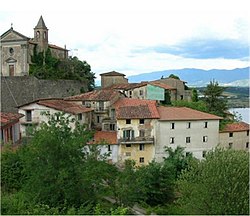
A ghost town, deserted city, extinct town or abandoned city is an abandoned village, town, or city, usually one that contains substantial visible remaining buildings and infrastructure such as roads. A town often becomes a ghost town because the economic activity that supported it has failed or ended for any reason. The town may also have declined because of natural or human-caused disasters such as floods, prolonged droughts, extreme heat or extreme cold, government actions, uncontrolled lawlessness, war, pollution, or nuclear disasters. The term can sometimes refer to cities, towns, and neighborhoods that, though still populated, are significantly less so than in past years; for example, those affected by high levels of unemployment and dereliction.

A comune is an administrative division of Italy, roughly equivalent to a township or municipality. It is the third-level administrative division of Italy, after regions (regioni) and provinces (province). The comune can also have the title of città ('city').
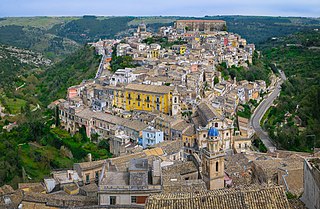
Ragusa is a city and comune in southern Italy. It is the capital of the province of Ragusa, on the island of Sicily, with 73,288 inhabitants in 2016. It is built on a wide limestone hill between two deep valleys, Cava San Leonardo and Cava Santa Domenica. Together with seven other cities in the Val di Noto, it is part of a UNESCO World Heritage Site.

Castiglion Fiorentino is a small, walled city in eastern Tuscany, Italy, in the province of Arezzo, between the cities of Arezzo and Cortona. It is known for its annual festivals and its Etruscan archeological site.
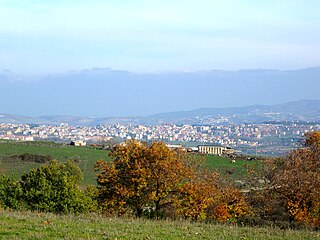
Rionero in Vulture is a town and comune in the province of Potenza, in the southern Italian region of Basilicata. It is located on the slopes of Monte Vulture in the northern part of the region. The village was founded and historically inhabited by the Arbëreshë minority, who no longer retain the language and the cultural Arbëreshe heritage.

Bibbiena is a town and comune in the province of Arezzo, Tuscany (Italy), the largest town in the valley of Casentino. It is located 60 kilometres (37 mi) from Florence, 30 kilometres (19 mi) from Arezzo, 60 kilometres (37 mi) from Siena, and 20 kilometres (12 mi) from the Sanctuary of La Verna. There are approximately 11,833 inhabitants

Eugenio Calò was an Italian Jewish resistance fighter during World War II. Born in Pisa to an old Sephardi family, he was posthumously awarded the Gold Medal for Military Valour, Italy's highest honor for heroism. Eugenio Calò was an Italian partisan, second in command of the Pio Borri partisan division that fought the Germans in the Casentino mountains in Tuscany. As a Jewish victim of fascist Italy during the Second World War, Calò had lost his workshop, his home, and his family. Finally, at the age of 38, he was captured, tortured and murdered by the Germans.

Montevarchi is a town and comune in the province of Arezzo, Tuscany, Italy.
Castelnuovo or Castel Nuovo may refer to :

Castelnuovo della Daunia is an Italian municipality (comune) with 1365 inhabitants in the province of Foggia in Puglia, Italy.

Rorà is a comune (municipality) in the Metropolitan City of Turin in the Italian region Piedmont, located about 50 km southwest of Turin
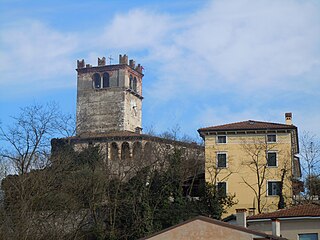
Castelnuovo del Garda is an Italian comune (municipality), in the Province of Verona, in Veneto, on a couple of morainic hills few kilometers south-east from Lake Garda. Verona is about 20 km to the east, Venice is 140 km east and Milan 140 km west.

Bucine is a comune (municipality) in the Province of Arezzo in the Italian region Tuscany, located about 45 kilometres (28 mi) southeast of Florence and about 20 kilometres (12 mi) west of Arezzo.

San Biagio Saracinisco is a comune (municipality) in the Province of Frosinone in the Italian region of Lazio, located about 120 kilometres (75 mi) east of Rome and about 50 kilometres (31 mi) east of Frosinone.

Mestre is a borough of the comune (municipality) of Venice, on the mainland opposite the historical island city in the region of Veneto, Italy.
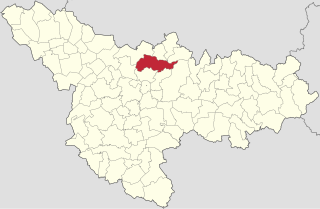
Pișchia is a commune in Timiș County, Romania. It is composed of five villages: Bencecu de Jos, Bencecu de Sus, Murani, Pișchia and Sălciua Nouă.

The Florence–Rome railway is part of the traditional main north–south trunk line of the Italian railway network. The line is referred to by Ferrovie dello Stato as the Linea Lenta to distinguish it from the parallel high-speed line. The Linea Lenta is now mainly used for regional services, for the InterCity services — rather than the faster Le Frecce trains — between Florence and Rome and for the majority of freight trains. Some types of passenger train are routed on the line to serve smaller stations not served by the high-speed line or in order to improve traffic flow during peak periods or other periods of congestion.

The Valdarnese, also referred to as Valdarnese Bianca, Valdarno Bianca or Pollo del Valdarno, is a breed of large white chicken from the upper Valdarno, the valley of the Arno river, in Tuscany, central Italy. It became virtually extinct in the 20th century, but the population is recovering. It is a different breed from the Valdarno chicken, which originates in the lower part of the Valdarno, and is black.
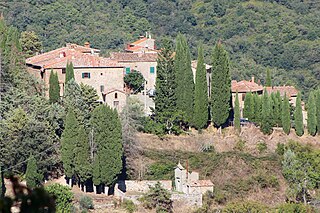
Starda is a village in Tuscany, central Italy, administratively a frazione of the comune of Gaiole in Chianti, province of Siena.
